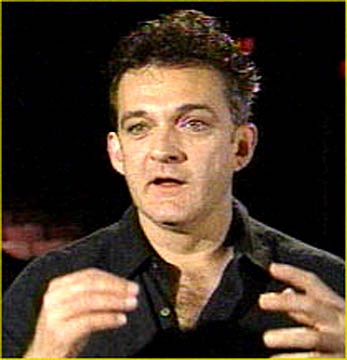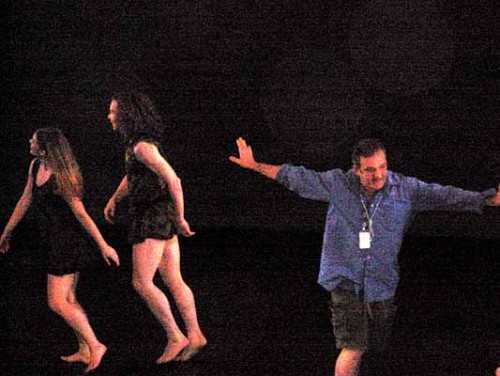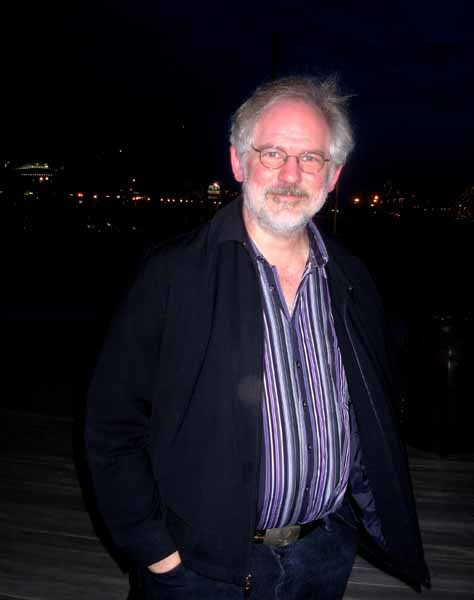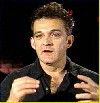Mark Morris Dance Group at the ICA
Poss Family Sponsors World Premiere
By: Charles Giuliano - May 16, 2007
"Looky" Music: Kyle Gann- "Studies for Disklavier" (Tango da Chiesa, Despotic Waltz, Bud Ran Back Out, Folk Dance for Henry Cowell, Texarkana). Costumes: Elizabeth Kurtzman, Katherine McDowell, Isaac Mizrahi, Martin Pakledinaz, Susan Ruddie, Christine Van Loon). Lighting: Michael Chybowski. Dancers: Craig Biesecker, Samuel Black, Joe Bowie, Charlton Boyd, Elisa Clark, Amber Darragh, Rita Donahue, Lauren Grant, John Heginbotham, David Leventhal, Laurel Lynch, Bradon McDonald, Dallas McMurray, Maile Okamura, Noah Vinson, Jenn Weddel, Julie Worden, Michelle Yard.
The A list of the Boston art world including trustees, patrons, mavens, fashionistas and gallerists were packed into the mid-scale theatre of the new Institute of Contemporary Art, for the opening night of the 25th anniversary tour of the Mark Morris Dance Group which featured the world premiere of "Looky" set to music for the disklavier by composer/ critic, Kyle Gann, and the Boston premiere of "Candleflowerdance" to "Serenade in A" by Igor Stravinsky.
So, what's a disklavier, you well might ask. It appears to be a grand piano altered with a computer program that functions like the vintage player pianos. The instrument was featured and spotlighted on a corner of the stage in a choreography which worked on variations of geometric squares within squares. The first piece "performed" by the doctored instrument "Tango da Chiesa" featured avant-garde polyrhythm with a clanging clustery sound. We braced ourselves for a clash and clatter dance. But each new segment of music was different from the last and the mechanical/ computer programmed instrument proved to be more precise and prolific than the most adroit and technically adept hands on performer. There were passages of bristling speed and fluency as well as time of lilting legato, elements of Harlem stride piano, jazzy bop and a bit of hoedown, yeh haw, Americana.
It proved to be a zany/ gonzo, eclectic suite accented by the disjunctive costuming by six designers each with their own style and touch that ranged from tailored simple elegance, pants and dress shirts, to Captain Midnight, Cowgirls with the blues, high end hookers in Harem, bare midriff slinky pants and top, a dancer in a star clustered unitard, and a stocky, bare chested dancer wearing a long flared coat like those of rococo aristocrats. The disparity of look of the dancers accented their distinctive roles and personalities in a piece that was as much about pantomime and drama as it was about movement and dance. Now in his 50s, Mark Morris, as choreographer and artist, seems determined to reach out for the greatest possible evocation of his decades of acquiring a vocabulary of movements and close marriage to the inspirations and demands of the live performance of music and to strive for even greater stretches of drama and narrative interpretation.
Much of the mélange of sound, character and narrative movement proved to be so experimental and over the top that the audience seemed hard pressed to keep up. Particularly when compared to the more conventional, classic/modernist pairings and group ensemble works, twos, fours and sixes, male/female of the other now more clear and obvious works on the program including: "The Argument" to music of Robert Schumann, from 1999, now looking almost Balanchine, or the somewhat, but only slightly more modernist "Candleflowerdance" set to Igor Stravinsky.
During the first segment of "Looky" there was a square marked by simple, metal, straight backed chairs. Facing us stage right is a fancy costumed gentleman who "observes" the entrance and exit of dancers at times even directing the flow of traffic through the space. Occasionally the dancers end a sequence by literally facing the stage right wall in a row. The "Looky" aspect involved the dancers walking about examining their surroundings from star gazing, to staring at the ground, out into the audience. and to stage right of the large square, a small one spotlighted with a seeming hole of light penetrating like a laser beam through the stage floor. From time to time they peer down into that space. While this is happening the bare chested dancer is draped over the unmanned piano bench.
But signifiers of any Morris choreography are surprise and change. Just when you get lost and confused he snaps us back into something comforting and familiar, from ersatz country, and Texas swing, to jitterbug and even a send up of a chorus line, Broadway shuffle. Overall, it was a tough act and more than the audience could absorb. Perhaps with time it will be better understood and take its place in the canon. But, for now, oh my. What a piece of work. The audience gave it a polite round of applause. This is, after all, Boston. About four patrons burst to their feet but the curtain fell before there was any hint of a standing O.
During an intermission and a breath of fresh air on the ICA deck abutting Boston Harbor we happened to catch up with the composer Kyle Gann, for some 19 years, a writer on new music for the Village Voice. We asked how the Disklavier differed from the player piano rolls which were unable to convey the touch of the performer. By contrast he explained that the programs he uses allow for great nuance and variation of precisely these elements which simulate in a remarkable manner the "human" element. As to the music itself he mentioned being inspired by the bop pianist, Bud Powell, and emulating the Harlem Stride master, James P. Johnson. He also conveyed that it had been a great challenge to work with Morris and that he was surprised at precisely how the music was interpreted as dance. Morris is noted for sticking rather closely to the music so there was a real intimacy with the living composer.
Call me old fashioned but I most enjoyed "The Argument" which proved to be accessible on every level from the music of Schumann performed by Wolfram Koessel, cello, and Steven Beck, piano. There was real elegance in the pair of Charlton Boyd and Julie Worden, they were the primary couple, and the others included John Heginbotham and Michelle Yard, and Craig Biesecker and Maile Okamura. The women wore black dresses and the men black slacks and dress shirts. They expressed all of the possible combinations of love/hate, attraction/ repulsion, friendship/adultery, fighting/feuding and making up. It was thoroughly beautiful and enjoyable but compared to other parts of the program perhaps too mainstream and safe. This appears to be what Morris wants to move on from but also the kind of "hits" he has to insert into programs to please audiences.
Involving six dancers, and less obvious pairing than "The Argument", "Candleflowerdance", from 2005, like "Looky," was based on the simple geometry of a square. When "Looky" conveyed this by marking off the territory with the placement of chairs and through lighting accents, in this dance there is a literal square on the stage with a thick white line. It made us constantly aware of the rigid confines and edges of movements in and out of the square. There were moments when the dancers, lean, then tumble and fall forming an arrow head of bodies into the right angle of a corner. As the title indicated there was a row of lit candles in glass votive holders marking out an area just behind the square. It created a kind of metaphor of a "flash point" and "danger zone" from which the dancers were restricted. The candles worked as metaphor of romance as well as signifier of danger and anxiety which was conveyed in the dance itself. The piece is dedicated to the late Susan Sontag.
The evening ended with "Grand Duo" to music of Lou Harrison and costumes by Susan Ruddie. The work for fourteen dancers had the men bare chested (the women not) but some of the men wore skirts, like the women, which helped to blur gender identities. The dance moves seemed primal and unisexed with all of the dancers performing them simultaneously. I may be terribly wrong but the primal mood, circling, and pounding passages of rhythm accented with the dancers striking and slapping at their bodies, the arched, angular movements, all seemed to evoke a deconstruction of the greatest dance of the 20th century "Rites of Spring" by Stravinsky with choreography by Nijinsky. While experimental and "avant-garde" the 1993 piece seemed more accessible and cohesive than the new "Looky."
So, now in his 50s, no longer dancing, looking stocky and older, Morris is not the wild child of his medium. There is an astonishing legacy of more than 200 dances set over 25 years with his company. For an artist and creator on his level it is always about where to go from here. Surely he has a measure of audience and foundation support that is rare. He heads a large company and school with many mouths to feed. But it can also be lonely at the top and how to avoid the traps of repetition. That said, the new work "Looky" raises as many questions as it answers. Is this an indicator of a bold new direction or just the folly of midlife crisis? For now, we have a lot of new information to absorb and reflect upon.




